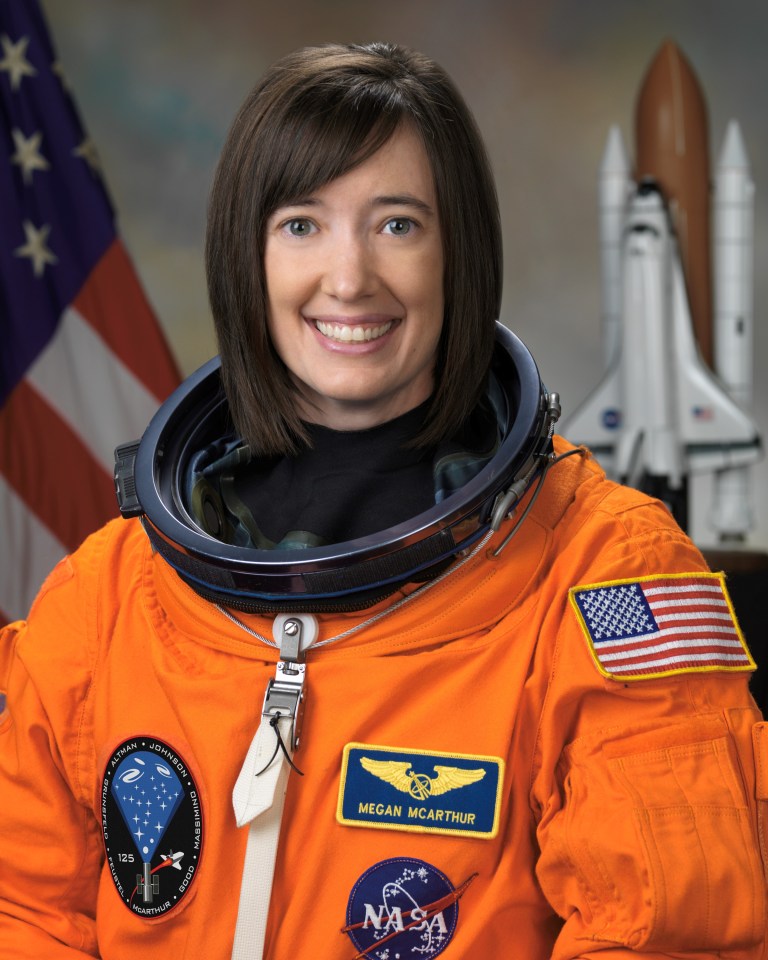
Megan McArthur
NASA Astronaut
Follow Megan
Summary
Megan McArthur was selected as an astronaut in 2000. She holds a Bachelor of Science in Aerospace Engineering from the University of California, Los Angeles and a Ph.D. in Oceanography from the University of California, San Diego where she performed research activities at the Scripps Institution of Oceanography. McArthur served as a Mission Specialist aboard STS-125, the final space shuttle mission to the Hubble Space Telescope. The successful mission improved the telescope’s capabilities and extended its life – it is still in operation today. In completing her first space mission, McArthur has logged almost 13 days in space. She most recently served as pilot of the SpaceX Crew Dragon spacecraft, named Endeavour, and NASA’s SpaceX Crew-2 mission which landed November 8, 2021. It was the second commercial crew rotation mission aboard the International Space Station and the third crewed flight for that spacecraft. She also served as Flight Engineer of Expedition 65/66 on the International Space Station.
Personal
Born in 1971 in Honolulu, Hawaii. Considers California to be her home state. Married with one child. Parents Don and Kit McArthur reside in San Jose, California. Megan enjoys SCUBA diving, backpacking, and cooking.
Education
Graduated from St. Francis High School, Mountain View, California, 1989; Bachelor of Science in Aerospace Engineering from University of California, Los Angeles, 1993; Ph.D. in Oceanography from University of California, San Diego, 2002.
Experience
At the Scripps Institution of Oceanography, McArthur conducted graduate research in nearshore underwater acoustic propagation and digital signal processing. Her research focused on determining geoacoustic models to describe very shallow water waveguides using measured transmission loss data in a genetic algorithm inversion technique. She served as Chief Scientist during at-sea data collection operations, and has planned and led diving operations during sea-floor instrument deployments and sediment-sample collections. While at Scripps, she participated in a range of in-water instrument testing, deployment, maintenance and recovery, and collection of marine plants, animals and sediment. During this time, McArthur also volunteered at the Birch Aquarium at Scripps, conducting educational demonstrations for the public from inside a 70,000 gallon exhibit tank of the California Kelp Forest.
NASA Experience
Selected as a Mission Specialist by NASA in July 2000, McArthur reported for training in August 2000. Following the completion of two years of Astronaut Candidate training and evaluation, she was assigned to the Astronaut Office Shuttle Operations Branch working technical issues on shuttle systems in the Shuttle Avionics Integration Laboratory (SAIL). She has also worked in the International Space Station and Space Shuttle Mission Control Centers as a Capsule Communicator (CAPCOM) and has served as a Crew Support Astronaut for Expedition Crews during their six-month missions aboard the International Space Station. McArthur was the Astronaut Office Lead for visiting vehicles during the first commercial cargo missions to the International Space Station. She most recently served as the Deputy Chief of the Astronaut Office, supporting crews in training and aboard the International Space Station.
Spaceflight Experience
STS-125 (May 11 through May 24, 2009). This was the fifth and final Hubble Space Telescope servicing mission. McArthur worked as the flight engineer during launch and landing. She served as robotic arm operator as she carefully retrieved the telescope and placed it in the shuttle’s cargo bay. The 19-year-old telescope then spent six days undergoing an overhaul during 5 days of spacewalks. The spacewalkers were supported by McArthur operating the robotic arm. The team overcame frozen bolts, stripped screws, and stuck handrails. The refurbished Hubble Telescope then had four new or rejuvenated scientific instruments, new batteries, new gyroscopes, and a new computer. The STS-125 mission was accomplished in 12 days, 21 hours, 37 minutes and 9 seconds, traveling 5,276,000 miles in 197 Earth orbits.
Crew-2 (April 23, 2021 – November 8, 2021) was the second commercial crew rotation mission aboard the International Space Station and the third crewed flight for that spacecraft. She also served as Flight Engineer on the International Space Station for Expedition 65/66. She contributed to many things while aboard the station including a host of scientific investigations, technology demonstrations, and maintenance activities. She completed 199 days in orbit during this mission.
Pronunciation
MEH-gun MACK-arthur


























